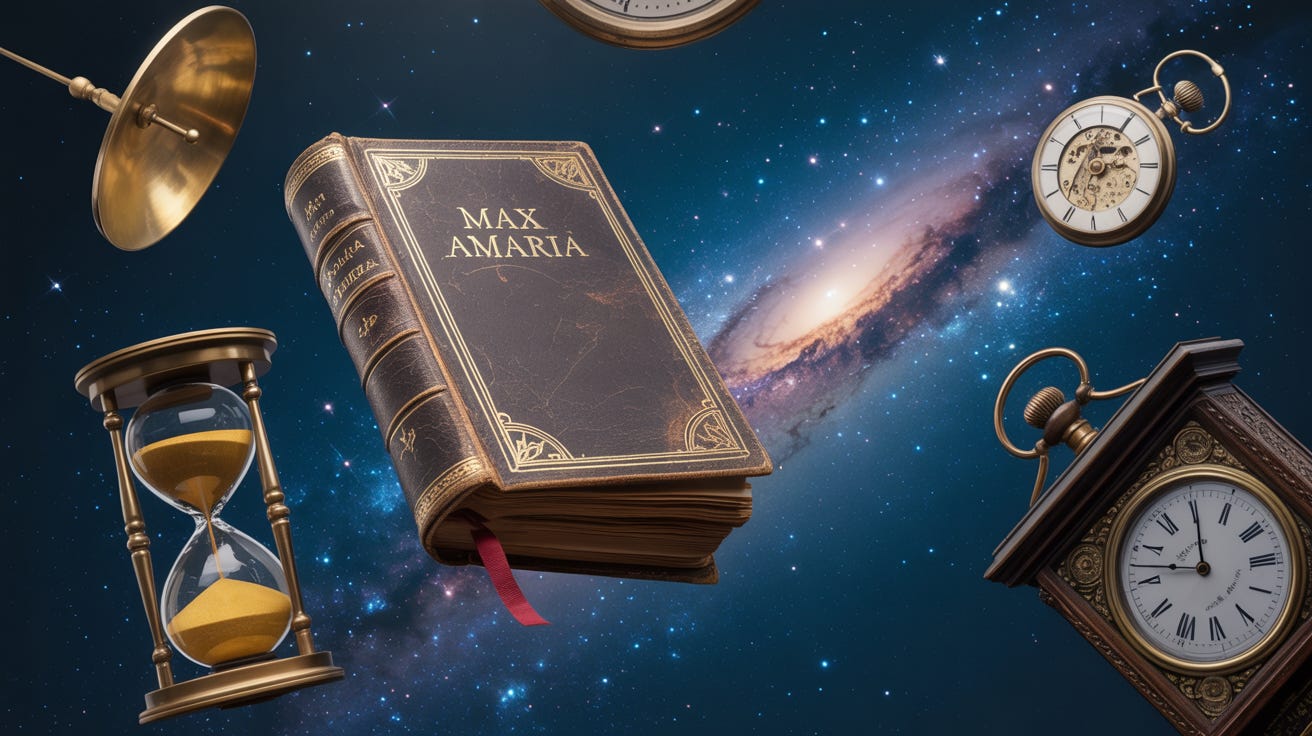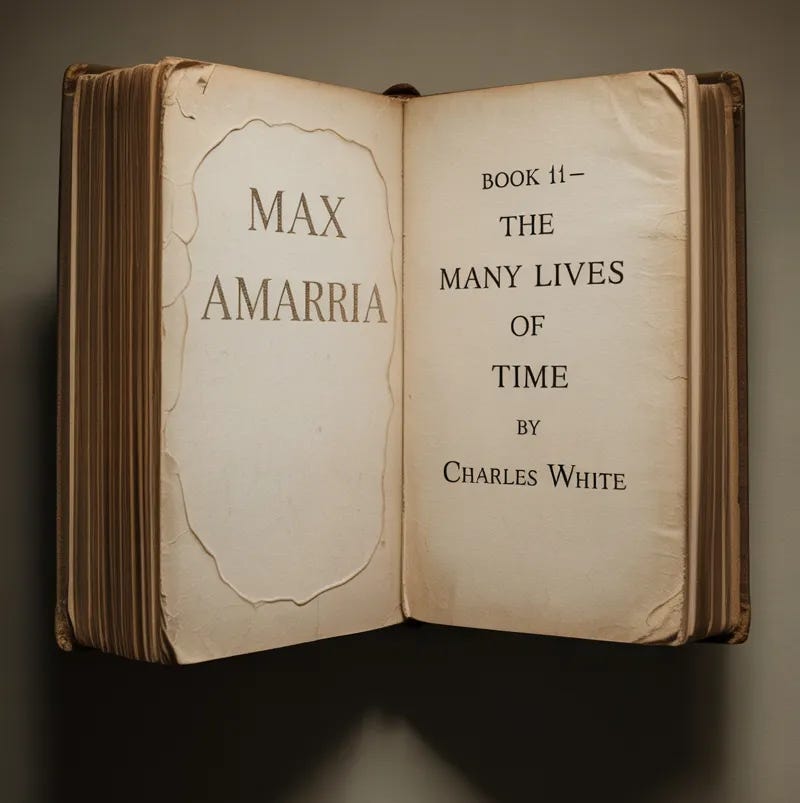Opening Reflection
By Charles White
I have known the many lives of time.
I have known time when it moved like stone.
I have blinked, and found a year gone.
I have lived through 7 minutes of terror, and that time seemed like an error.
I have stood fire watch from Vetter Mountain, while cloud shadows crawl across the Angeles National Forest and wondering where did the entire weekend go?
I have lost hours in conversation under the stars, and no one checked the time.
I have danced at Burning Man in dust storms and twilight, only to realize the moon had come and gone, and the sun was kissing the dawn.
Time has never treated me the same way twice.
It has crept. It has raced. It has held its breath. It has vanished entirely.
I have lived its many versions. And if you’re honest with yourself, so have you.
So this book is about what time is. It’s also about what time feels like. I’m going to take you further than most know of time because it’s about the way cats feel it differently than flies. The way astronauts measure it differently than monks.
But it’s also real, it’s physical not just emotional. Let’s get into the science of time because time is not one thing. It is many lives, unfolding at once.
Make some time, let us talk about the many lives of time, so let’s begin.
Max Amarria – Book 11
The Many Lives of Time
Chapter 1 - The Emotional Time Warps
You’ve felt it. Everyone has.
Time doesn’t always feel the same, even when the clock insists it is. One minute can stretch into a gray forever, while another disappears before you can hold it. This isn’t just poetic language—it’s the truth of how our brains experience time.
Think about a Monday morning that’s already gone wrong. The kind where nothing’s working, your coffee is cold, and your calendar is full of meetings that seem designed to drain your soul. You glance at the clock, hoping an hour has passed, only to discover that it’s been seven minutes. In moments of stress, boredom, or discomfort, time drags its feet. The brain becomes vigilant, counting the seconds, watching the clock, analyzing every pause.
On the other hand, imagine the exact opposite. You’re deep in conversation with someone you adore. Or you’re playing a game that lights up your imagination. Or dancing, laughing, immersed in joy. In those moments, time isn’t slow—it’s silent. It slips past you because your mind is no longer measuring it. The clock fades, and only the moment remains.
This effect is rooted in how the brain processes stimulation. During dull or painful experiences, our awareness heightens, searching for change, tracking every detail. But in joyful or engaging states, especially those described as “flow,” the brain disengages from tracking time altogether. It no longer keeps count. It simply lives.
There’s a reason childhood summers felt so long. The world was new. Novelty slows down our perception of time because the brain records more data. Each day contained firsts. First bikes. First friends. First discoveries. But as adults, when routines repeat and days blur together, the mind compresses the memory. That’s why a year can pass in what feels like a blink.
Emotional time is elastic. It is shaped not by seconds but by significance. A boring lecture stretches because it’s unmoored from meaning. A thrilling concert ends too soon because it was saturated with it. Trauma can make a single second last forever, while healing may take months that feel like hours.
We often say time flies when we’re having fun. But what really happens is this: we stop noticing the clock. We step outside the structure. In those rare, beautiful instances, we experience time not as a ruler, but as a feeling.
And in that feeling, it changes shape.
Max Amarria – Book 11
The Many Lives of Time
Chapter 2 - The Species of Time
As a human, you think you know time. But what about non-humans? Time is not the same for other species than it is for us.
We think of time as universal. One minute is one minute, no matter who or what you are. But that assumption only holds true inside the human experience. Step outside of it, and time starts to unravel.
A fly experiences over two hundred frames of visual information every second. What feels like a blink to you becomes a detailed, slow-motion movie in the world of a fly. That’s why it can dodge your hand before you even realize you moved. Its life may be short, but it is dense, packed with sensation, decision, and reaction. From the fly’s point of view, your world unfolds in exaggerated slow motion, filled with towering creatures that move like glaciers.
A cat sees more clearly than we do, and not just with its eyes. It perceives time differently. With a slightly higher critical flicker fusion rate, the world appears more fluid to a cat, particularly when danger or opportunity arises. This subtle edge allows it to read motion as if it were already in the future. That’s why the snake misses. The cat doesn’t just react to the strike—it anticipates it, shifts its weight, and finishes the encounter before the snake’s motion is fully committed.
We humans exist somewhere in the middle. Our visual processing hovers around sixty frames per second. It’s enough for storytelling, for driving, for keeping track of a conversation. But it’s not fast enough to catch a fly, and not precise enough to rival the reflexes of a feline predator. That limitation may be what led us to build tools for measuring time. Calendars and clocks were inventions designed to compensate for the narrow scope of our perception.
But if you really want to be humbled, look not at the animal kingdom, but at the trees.
If a tree could see, and it watched you pass by, it might not register your presence at all. Or perhaps it would see you only once, like the brief flare of a meteor. Trees live in rhythms we barely understand: the slow dance of sap, the leaning of limbs toward sunlight, the patient clutch of roots through stone. Their experience of time, if they have one, would be unhurried, expansive, and entirely indifferent to our fast lives.
A Native American elder once told me, “When you have the big view, you can see mountains move like clouds.” That line stayed with me. It makes more sense each year. I think of it when I watch time-lapse videos of a forest waking up or a city pulsing with headlights. Only when you step outside the human clock does the shape of time begin to change.
So no—one minute is not the same for everyone. Not even close.
Time begins with biology, but it doesn't stop there.
It is felt differently by every living thing.
And for some, it’s not even felt at all.
Max Amarria – Book 11
The Many Lives of Time
Chapter 3 - The Physics of Time
Until now, time has been a matter of feeling, of how living things perceive the flow. But time also exists in the hard structure of the cosmos. In Einstein’s universe, it is not merely a background. It is a dimension, woven into space, bent by mass, and slowed by speed.
Start with something simple: gravity.
The stronger the gravity, the slower time passes. This is not theory anymore. It has been measured, confirmed, and is corrected for every single day. Atomic clocks placed on mountaintops tick just a bit faster than identical ones at sea level. Your head, being farther from Earth’s center than your feet, experiences slightly more time. The difference is unimaginably small, but it is real. Stand tall for a lifetime, and your skull will be nanoseconds older than your toes.
Now look farther out. GPS satellites orbit high above Earth, where gravity is weaker and orbital speed is high. These satellites experience both effects. Gravity makes their clocks run faster than those on Earth. Speed makes them run slower. The net effect is a gain of thirty-eight microseconds per day. Engineers have to program this correction into every GPS satellite or your phone would misplace you by miles. In that sense, your location on Earth is confirmed daily by Einstein’s math.
Go further still. Astronauts aboard the International Space Station move at nearly eight kilometers per second. Because of their speed and orbital altitude, they age more slowly than people on the ground. The difference is slight, about five milliseconds for a six-month mission, but it proves a point. Time does not flow equally everywhere.
Now imagine falling toward a black hole. As you descend into its gravity well, time slows. From your perspective, everything feels normal. But to someone watching from afar, your fall becomes slower and slower. At the edge, it appears to freeze. In their frame of reference, you never quite arrive. Your final moment stretches out into eternity. But for you, the journey ends quickly and completely.
And then there is the photon, the particle of light. It travels at the speed limit of the universe. At that speed, time itself collapses. From the photon's perspective, there is no journey. No distance. No before or after. The moment it is created and the moment it is absorbed are the same. To a photon, the universe has no clock. Everything happens at once.
These are not metaphors.
These are physical truths. We send spacecraft to verify them, and we build our navigation systems around them. Time bends with mass. Time bends with velocity. In the physical world, time is elastic. Even our most distant messenger, Voyager, must account for this. It cannot aim directly at Earth when sending its faint signal home. Instead, it must point slightly ahead, calculating where Earth will be by the time the signal arrives. Voyager does not communicate with where we are. It speaks to where we will be, in that future time.
Here on Earth, as we live our days minute by minute, we are always moving through time slightly differently. It depends on where we are, how high we stand, how fast we move, and how close we are to the pull of gravity.
Time is not just something we feel.
It is something the universe shapes.
Max Amarria – Book 11
The Many Lives of Time
Chapter 4 - The Mystery of Time
We have clocks that count it. We have calendars that divide it. We build lives around it. And what we know is this: time is real.
It is not abstract or imagined. It is observable, it is measurable, and it shapes everything that changes. We know it flows in one direction, always forward, and we know it can bend in the presence of gravity or speed.
We may still be uncovering its deeper nature, but we are not in the dark. We are in the process of understanding and testing its limits.
Time feels obvious. You wake up. You age. Things change. It must be real. And yet, the more deeply we investigate, the stranger time becomes. It is part of every experience we have, but it does not behave like anything else in nature.
We did not invent time itself. What we invented were tools to track it. Sundials. Water clocks. Mechanical gears and digital pings. These are human creations. They serve us by giving structure to the world. But what they measure is not human-made. What they measure is motion and change.
A day is a spin of the Earth. A month is the rhythm of the Moon. A year is the long arc around the Sun. We used what we could see to build a scaffolding of hours and minutes. Time, in that sense, is a measurement. But that measurement emerged from something deeper.
The real question is not whether time exists, but what time truly is.
In physics, time is a dimension, the 4th dimension, part of the fabric of space itself.
We always call it, space/time.
You can move through space in any direction, but time appears to move in only one. We call that the arrow of time. It points from past to future. From birth to death. From potential to memory.
And yet, the laws of physics do not require this one-way flow. The equations work just as well in reverse. Nothing in the math says time must move forward. But in our world, it does. Always.
One explanation is entropy. The universe tends toward disorder. Eggs do not unscramble. Smoke does not return to the match. In this view, time is simply the way we track that increasing disorder. It is not a fundamental force, but a consequence of the universe unfolding. The great unfolding.
Another possibility is that time emerges from consciousness. Maybe time is the way a brain keeps track of change. Perhaps it is not out there in the world, but in here, inside our perception. If that is true, then time may not be a thing at all. It may be a sensation.
WARNING: I’m about to talk about light and time…
Then there is the photon of light. It moves at the speed of light and experiences no time at all. From its perspective, the moment it is born and the moment it is absorbed are one and the same. It travels the entire width of the cosmos without ever aging. If that does not hurt or bend your mind, then congratulations to you.
This simple particle defies our understanding. It does not experience before or after. It does not have a past or future. It just moves through the universe without time. And when you realize this as truth, your mind screams… OUCH.
Which leaves us with a beautiful paradox.
Time feels real. We are shaped by it, ruled by it, haunted by it. We live inside it. But we also create it with every heartbeat and every thought.
We cannot see it, but we cannot ignore it.
We cannot hold it, but we cannot escape it.
Time may not be a thing.
It may be the relationship between all things.
And in the end, that may be what makes it most real of all.
Actions for Book 11:
The Many Lives of Time
Contemplate:
You now know that time is not a constant.
It bends for light, slows in gravity, stretches under emotion, and races through routine.
Ask yourself: How much of your life have you measured, and how much have you actually lived?
When was the last moment you truly stepped outside the clock and felt the shape of time without naming it?
What if time is not just passing through you, but also being shaped by you?
Sit with that idea. Let it disturb the still waters. Let it bend your mind.
You are not merely inside time. You are a co-creator of its texture.
Practice:
Once each day, step out of the measured world.
Do something without checking a clock.
Let one conversation run long.
Let one morning move slow.
Let one moment linger in silence.
Then record it—not with a timestamp, but with meaning.
Write down not what time it was, but what it felt like.
This is how you teach your nervous system to see beyond the clock.
Over time, you will begin to notice time itself.
Not as a schedule, but as a living medium.
Not as a prison, but as a river you can swim with, not against. Enjoy the currents.
The Commandment:
“Thou shalt not live only by the clock.”
Let some part of your life belong to mystery.
Time will pass no matter what. Life is short.
Let it pass as something beautiful.
Bonus Content
A Poem for Time
by Charles White, and Gloria Page Tate
I have known time when it moved like stone,
Where seconds stood and I felt alone.
I have blinked and found a year gone by,
With no goodbye, no reason why.
I’ve lived through terror, seven long minutes wide,
Each heartbeat stretched as hope and fear collide.
I’ve watched the clouds crawl through the trees,
While weekends vanished on a fire-watch breeze.
I’ve lost whole nights in a single talk,
With moonlight pouring on a desert walk.
No one counted, no one cared,
Because time, for once, was simply shared.
So mark it not by clocks or crowds—
But by the place where
mountains move like clouds.
Next Book:
Previous Book:
Disclaimer and Copyright
All books of Max Amarria were written and created by Charles White,
also known as The Space Pope, Max Singularity.
It is offered freely and should never be sold, resold, or used for profit.
This work was made as a gift of thought, reflection, and shared knowledge—
not as a product.
It may be shared, quoted, copied, printed, or distributed only in full or with proper attribution to the author, and never for commercial purposes.
No one is authorized to charge for it in any format.
It is copyrighted by Charles White, and all intellectual property rights are retained.
If you found value in these words, share them freely—just as they were offered freely.
Knowledge is for lifting, and for sharing. Not for locking away.
© 2025 Charles White. All rights reserved.







Well said Charles and well written. Love the poetry.